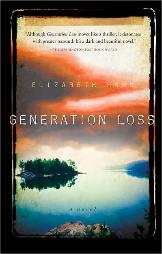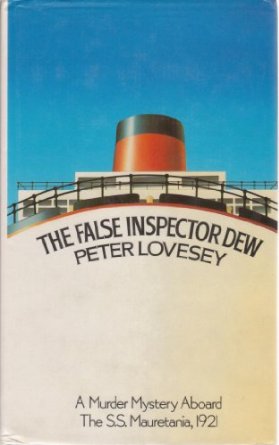Generation Loss, by Elizabeth Hand (2007)
 (Those who read Crime Blog #1 will know I was intending Richard House’s The Kills to be my next excursion into the genre. I was just getting into it when we went to Spain – and anyone who’s seen the book in the flesh, so to speak, will understand why it wasn’t really practical to take it with me. So I took Generation Loss instead – much more acceptable in terms of the EasyJet baggage allowance. But fans of House fear not, The Kills will be featuring at this blog in due course.)
(Those who read Crime Blog #1 will know I was intending Richard House’s The Kills to be my next excursion into the genre. I was just getting into it when we went to Spain – and anyone who’s seen the book in the flesh, so to speak, will understand why it wasn’t really practical to take it with me. So I took Generation Loss instead – much more acceptable in terms of the EasyJet baggage allowance. But fans of House fear not, The Kills will be featuring at this blog in due course.)
I’ve been a fan of Elizabeth Hand for quite some time now. I admire her writing greatly. I also sympathise with her preoccupations, which might loosely be described as the materials of obsession. Her characters are often loners, people who have become disaffected with society, who have fallen out with friends and lovers, who for one or other reason find themselves treading an unkempt path, often of their own making. Above all, Hand is interested in art and artists, but where some might portray art as a curative, for Hand’s protagonists it is more likely to be a purgative, an expression of the rage that is at least a part of their personal predicament.
One of the other things I love about Hand’s writing is her particular approach to the fantastic. Her touch here is always subtle – a leaching away of normality rather than a full-throated plunge into the surreal – and at least a measure of what we take as ‘unreal’ in her stories comes down to the skewed viewpoints and preternatural talents of her characters. Hand’s place in the canon of the fantastic is deservedly secure, and well recognised, which is why it came as something of a surprise to me that Generation Loss was being marketed as crime, pure and simple, with no fantastical element.
I was eager to find out what Hand might do with reality in the raw.
Generation Loss introduces us to Cassandra Neary, famous for fifteen minutes in her early twenties as a precociously gifted photographer whose images of the New York punk scene both shocked and enthralled a public hungry for sensation. Now in her forties, Cass is a burnt out case. Working as a bookstore clerk and still determinedly hooked on addictive substances, she has neither the wish nor the stamina to restart her career. When a former associate offers her the chance to interview Aphrodite Kamestos, a once iconic photographer who is now a bitter recluse living on a desolate island off the coast of Maine, Cass says no. What changes her mind is not the generous paycheque on offer, but the thought of meeting Kamestos, whose groundbreaking work was Cass’s own core inspiration. But there are secrets buried on Paswegas, and Cass’s intrusion into the lives of the islanders will have deadly consequences.
So far as the writing is concerned, all Hand’s trademarks are here in force. The New York scenes are beautifully handled, but it is in the passages about the landscape of Maine that Hand truly shines. The sense of place evoked in this novel is a considerable achievement. Fans of Stephen King will inevitably be reminded of the bleakly closeted island ambience of Dolores Claibourne and ‘The Reach’ and even Storm of the Century. But Hand adds an extra edge of lyricism, a keenly sympathetic insight into the lives of the islanders and their understandable resentment of those ‘from away’. The beauty and the bleakness of Paswegas are given equal weight, and the small but compelling cast of characters come vividly alive on every page. I’ve held a longstanding ambtion to visit Maine, and Generation Loss reinforced it, big style.
An island community is the perfect setting for a crime story. All those buried emnities, coupled with the fact that you already have all your suspects conveniently gathered together in one place, gives the crime writer a ready and fascinating alternative to the cliche of the country house, and it’s no surprise to see a writer of Hand’s calibre manipulating these very elements with panache and skill.
With so much about this novel to admire, I was all the more disappointed that the book as a whole did not work for me. From about the midway point it became uncomfortably clear that there were two stories in this novel, one subtle and resonant and deserving of closer scrutiny, the other cliched and unbelievable and demanding a Hollywood production company. I kept wishing it would bugger off and let me read more about Maine, and Cass, and photography. Unfortunately it monstered in and ate everything, leaving nothing in its wake but the sense that Generation Loss is yet another particularly tragic (because the writing is so effortlessly lovely) example of why thrillers are usually unsatisfactory as literature.
The true story of Generation Loss has nothing to do with Denny Ahearn. The true story of Generation Loss is the story of Cass and Aphrodite, Cass’s burnout, Aphrodite’s jealousy of her youth and talent, the conversation they should have had about that – and would have done, surely, had the ten-a-penny thriller plot not been allowed to become the driving force behind the action. Hand does her best to justify and give depth to what happens, but these efforts failed for me, because she had already killed off the most interesting character in the book, and because I never gave a damn about Denny, who is never a character so much as a necessary plot device:
Monstrous as he was, Denny was the real thing. So was his work. He really had built a bridge between the worlds, even if no one had ever truly seen it, besides the two of us. (p 317)
No he hadn’t – what Denny built was a freak room, the same as you see at the end of Silence of the Lambs and just about every serial killer thriller from The Texas Chainsaw Massacre to The Shining Girls, the hidden chamber of memento mori that has become de rigeur in such dramas not through any real sense of story or narrative tension (these were killed off after about the twentieth time this tired old trope was employed) but because of the cod symbolism that passes for explanation of motive, and because those scenes, often played out in the half-dark, always look great on camera.
I finished Generation Loss deeply regretting the novel it should have been. That is, not a novel of generic crime fiction, but a novel about the corrosive nature of ambition and the damage it does to relationships, with other people and with the world. It’s unfair of me to twist someone else’s book to my own agenda, I know, especially as it’s precisely the very high quality of Hand’s writing that allows me to forget about the language and to focus instead on what I perceive as the novel’s problems.
But what I take away most of all from this book, apart from my continuing admiration for Hand’s talent and leading on directly from what I was saying in an earlier post about the inherent conservatism of the publishing world, is a feeling of concern. Concern about the commercial pressures brought to bear upon writers to produce stories that can be easily assimilated, stories, in other words, that we’ve all heard before.
Last night, Chris and I caught up with a movie we wanted to see but missed earlier in the year, Derek Cianfrance’s The Place Beyond the Pines. The movie begins with Luke, a stunt motorcyclist (played by Ryan Gosling) who more or less accidentally discovers that he is a father. Wishing to play an active role in his baby son’s life, he throws over the itinerant carnival existence he has been leading and turns to bank robbery as a misguided way of making money to support his new family. We as audience know from the first that this is bound to end badly, and as we watch Luke speeding towards a police roadblock we believe we know everything there is to know about what comes next. We’ve seen so many other films like this, after all. Only as it turns out, we haven’t. The Place Beyond the Pines is as far from the by-the-numbers three-act Hollywood cop drama as it is possible to get. What we are offered instead is an original and arresting piece of work, beautifully scripted, powerfully acted and never afraid to be true to its own unique story. The plot, although it appears discursive, is actually masterfully structured – and solid gold proof that good stories are not rooted in formula, but in character, and landscape, and authentic mystery.
Could you call this film a crime drama? Yes, certainly. But more than that it is just a story about those people, full of surprises right up until the final frame, and so affecting and full of poetry that talking it over the following morning still brought tears to my eyes.
If stories like this prove anything, it’s that as writers we should have the courage to tell the stories we want to tell in the way we choose to tell them. Those are the kind of stories that catch fire.
